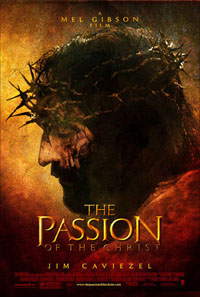 THE PASSION OF THE CHRIST
THE PASSION OF THE CHRIST(R)
***** (out of 5)
February 25, 2004
STARRING
Jim Caviezel as JESUS
Monica Bellucci as MAGDALENE
Maia Morgenstern as MARY
Hristo Naumov Shopov as PONTIUS PILATE
Francesco De Vito as PETER
Luca Lionello as JUDAS
Rosalinda Celentano as SATAN
Claudia Gerini as CLAUDIA PROCLES
Mattia Sbragia as CIAPHAS
Studio: Icon Productions/Newmarket Films
Directed by: Mel Gibson
BY KEVIN CARR
Moving. Powerful. Epic. Beautiful. These are only a few words I can think of to describe Mel Gibson’s controversial and highly anticipated film “The Passion of the Christ.”
I first heard about this film several months ago when the great distribution debate arose and the future of the film was in jeopardy. I must admit that at first I was confused at Gibson’s need to have all the dialogue in the authentic languages of Aramaic and Latin. After all, not even the best foreign film gets widely distributed in this country without an English soundtrack. Then I heard he didn’t even want subtitles, and I had to scratch my head and wonder what he was smoking.
Having seen the film, I humbly say that the use of the authentic language was brilliant. It added a level of authenticity to the film that is unattainable with English dialogue. And while about half of the dialogue is easy to guess based on the stories you might remember from Sunday school, the subtitles helped fill in the gaps in scenes that don’t contain such famous lines as “He who lives by the sword dies by the sword” and “My God, why have you forsaken me?”
But ultimately, the film isn’t dialogue driven. It is more of a movie mural painted on a canvas, an art form lost in the modern age. Taking advantage of the fact that practically the entire world is familiar with the story (and if you’re not, I’m not going to rehash it here; go pick up a Bible and look it up yourself), “The Passion of the Christ” shows Jesus’ last days from Gethsemane to the Resurrection with little explanation or exposition.
The true beauty of “The Passion of the Christ” is that it brings humanity to Jesus, who is all too often portrayed as unreachable. While Jesus was divine, he was also human, and he carried with him the baggage of humanity. This is no more apparent than when we see his suffering through the eyes of his mother Mary. Mary saw Jesus not as the Son of Man, but as her baby boy. As she watches him die, it is her son she sees, not her savior. This touched me the deepest because it was a stark reminder that Jesus’ pain was still human pain – and those who loved him as a man shared this pain on more than one level.
There are no big surprises, no plot twists. Bruce Willis doesn’t show up in the last few minutes, mow down the Roman soldiers with an AK-47 and free Jesus from the cross. But knowing the story doesn’t preclude it from being a great film. After all, you knew the astronauts would get home from Apollo 13, the U.S.A. hockey team would beat the Russians in the 1980 Olympics and the Titanic would sink in the North Atlantic.
Putting the life of Christ in a movie is nothing new, and neither is showing the Passion. Heck, Passion plays are performed throughout the country each year, and we all hear the story if we go to church around Easter. But Gibson did something remarkable by throwing the horror of Jesus’ last hours on the screen. Never has it been handled with such unapologetic brutality. It’s uncomfortable to watch, but it also dares you to think deeper about this particular moment in history.
Sure, if you’re thinking in the textbook Christian manner, you’d be likely to say, “Look at what He went through for me.” But the power of Gibson’s film is that it simply shows the pain Jesus endured. You just don’t get this hearing a monotone liturgist read the account in an echoing sanctuary on Sunday morning.
Often in the film, Jesus is set against another person – from Pontius Pilate to Simon who helped bear the burden of the cross – and we see a hint of reflection as if Gibson is saying to us, “If these people only knew how this would play out in history.” But again, the real power of the film comes from its ability to put ourselves in the position of Christ, knowing you are going to die, knowing this is your destiny and knowing that there is nothing you can do to stop it because you also know it is the right thing to do.
Gibson exercised tremendous control in this age of CGI to avoid making miracles overly flashy like most Hollywood films. No golden glow emerged from his hands when he healed the soldier’s ear in Gethsemane, and Satan (superbly portrayed by Rosalinda Celentano) flows in and out of the crowd like a specter rather than a special effect. A small amount of digital manipulation was shown to bring to life the torment of Judas, but this fit nicely into the film with subtle imagery, relying more on anticipation and imagination than flashy special effects.
“The Passion of the Christ” is one of the most powerful films I’ve seen in a long, long time. It drives home traditional Christian beliefs by modeling it on screen rather than preaching at us. For example, to see Jesus forgive the soldiers who have been tormenting him throughout his trials challenges us to live by example and forgive our own enemies.
This film may change your life. Then again, it may not. But ultimately, it inspires change – whether it be great or small – and this is all too rare in American cinema.

Great review!!!